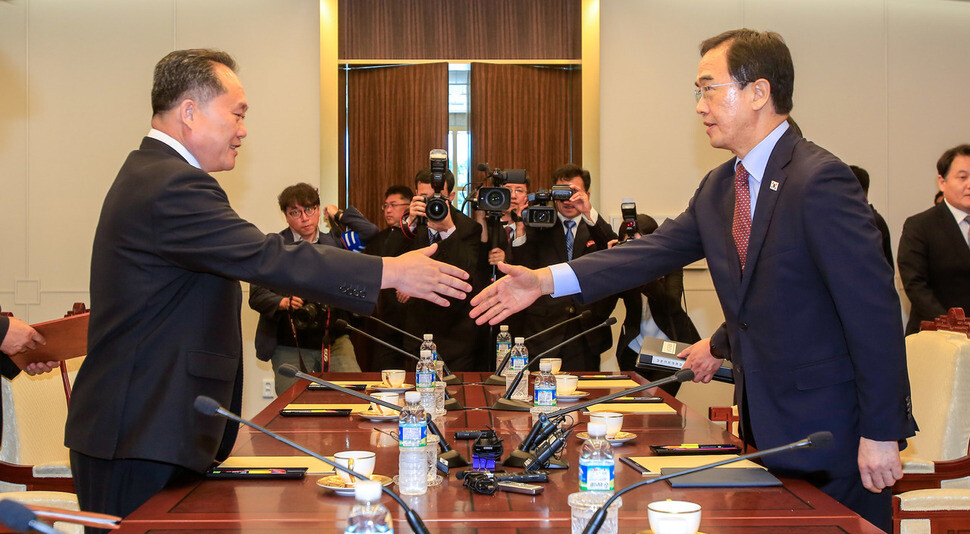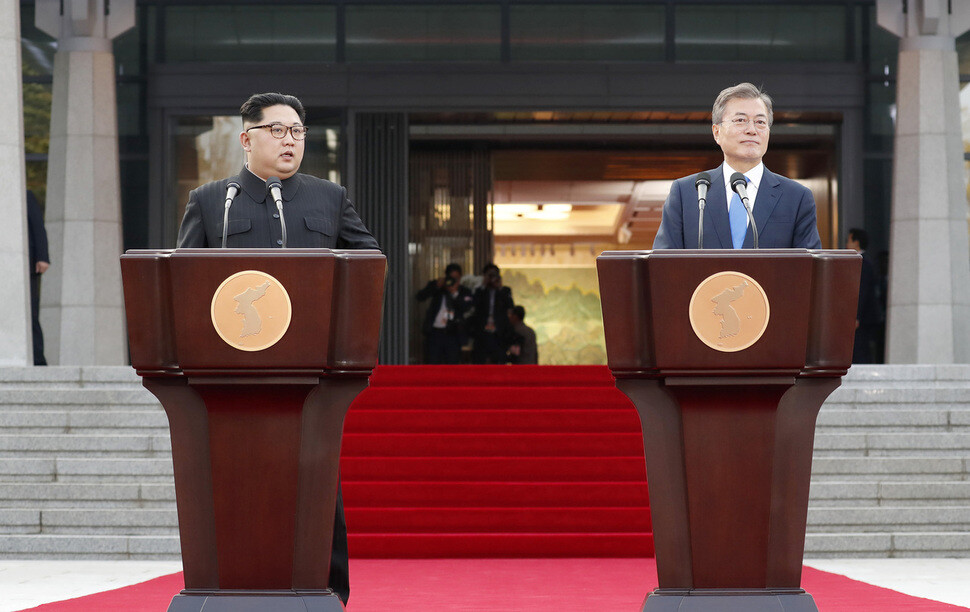hankyoreh
Links to other country sites 다른 나라 사이트 링크
High-level inter-Korean talks to take place in Panmunjeom on Aug. 13

High-level inter-Korean talks to discuss ideas for implementing the Apr. 27 Panmunjeom Declaration are to take place on Aug. 13 at the Unification House (Tongilgak) on the North Korean side of Panmunjeom.
The talks come over two months after the last high-level meeting on June 1. With the meeting coming amid signs of a stalemate in the political situation as North Korea and the US butt heads over the war-ending declaration and nuclear facility/material reporting and inspection issues, and as North Korea urges the South swiftly implement the Panmunjeom Declaration’s terms, observers are watching to see whether Seoul and Pyongyang can drum up some momentum at the talks and create improvements in their relations.

“This morning, the North sent a message proposing to hold high-level talks for implementation of the Panmunjeom Declaration at the Panmunjeom Unification House on Aug. 13 to review implementation of the declaration to date and discuss issues related to inter-Korean summit preparations, and we sent a message this afternoon agreeing to this,” the South Korean Ministry of Unification announced on Sept. 9.
The ministry explained that it plans to “form a delegation with Unification Minister Cho Myung-gyon as chief delegate.”
“At the talks, we plan to hold in-depth discussions with the North on ideas to expedite implementation of the Panmunjeom Declaration and the things that will be needed to hold a successful inter-Korean summit,” it added.
In short, the Aug. 13 meeting was suggested first by the North, with an agenda to consist of largely two areas: a review of the Panmunjeom Declaration’s implementation to date and discussions on inter-Korean summit preparations.
The time is certainly ripe for additional high-level talks. Major agreements from the last talks on June 1 have either already been implemented or have frameworks established for their implementation. Two rounds of general-level military talks have been held, and follow-up discussions are under way after meetings of the railway, road, and forestry cooperation subcommittee.
A list has been finalized for divided family reunions on Aug. 15, leaving only the actual event to take place. While there has been no official announcement of the opening of a joint inter-Korean liaison office at Kaesong, a ceremony is expected to take place sometime around Aug. 17.
“Within the [South Korean] government as well, there had been a sense that it was time to hold high-level talks and look generally at the methods and pace of the Panmunjeom Declarations’ implementation,” a senior government official said. This much is unsurprising.
Reasons for being cautious
But North Korea’s suggestion of “discussions on inter-Korean summit preparations” as an agenda item for the talks suggests some caution is warranted. The joint press release from the June 1 high-level talks included no mention of a summit, and the two sides have never openly discussed the summit issue at any of their minister-level talks since the first inter-Korean summit in 2000.
The only exceptional instance came with high-level talks on Mar. 29, where the two sides settled on a three-part agenda for a summit shortly after a North Korea visit early that month by Blue House National Security Office director Chung Eui-yong and National Intelligence Service director Suh Hoon to express Seoul’s agreement to the summit.
The “summit” the two sides agreed to discuss at the talks appears to refer to President Moon’s “agree[ment] to visit Pyongyang this fall” as mentioned in the Panmunjeom Declaration. Stressing that Seoul would first need to hear what the North has to say at the talks, multiple key Blue House officials cautiously predicted the preparations were likely for the fall meeting rather than “one-point talks” along the lines of those at a May 26 meeting at the Unification House.
Meanwhile, another source suggested, “We shouldn’t focus too much on the Panmunjeom Declaration’s language about ‘Pyongyang’ and ‘fall’ and rule out the possibility of a ‘one-point summit.’”
A source familiar with the situation in inter-Korean relations said, “My understanding is that South and North still have not reached any kind of agreement on a summit date or other specifics.”
The main practical issue is the need for the partial lifting of North Korea sanctions and other measures from the US and UN to make enough progress in inter-Korean relations to help jar the political situation out of its current signs of deadlock. This explains the cautious stance voiced by a former senior official and expert on inter-Korean relations, who said the talks’ outcome would be “difficult to predict.” Another source sounded a relatively optimistic note, suggesting that Pyongyang “would not have proposed talks in order to criticize the South.”
By Lee Je-hun, senior staff writer, and Kim Bo-hyeop, staff reporter
Please direct comments or questions to [english@hani.co.kr]

Editorial・opinion
![[Column] Park Geun-hye déjà vu in Yoon Suk-yeol [Column] Park Geun-hye déjà vu in Yoon Suk-yeol](https://flexible.img.hani.co.kr/flexible/normal/500/300/imgdb/original/2024/0424/651713945113788.jpg) [Column] Park Geun-hye déjà vu in Yoon Suk-yeol
[Column] Park Geun-hye déjà vu in Yoon Suk-yeol![[Editorial] New weight of N. Korea’s nuclear threats makes dialogue all the more urgent [Editorial] New weight of N. Korea’s nuclear threats makes dialogue all the more urgent](https://flexible.img.hani.co.kr/flexible/normal/500/300/imgdb/original/2024/0424/7317139454662664.jpg) [Editorial] New weight of N. Korea’s nuclear threats makes dialogue all the more urgent
[Editorial] New weight of N. Korea’s nuclear threats makes dialogue all the more urgent- [Guest essay] The real reason Korea’s new right wants to dub Rhee a founding father
- [Column] ‘Choson’: Is it time we start referring to N. Korea in its own terms?
- [Editorial] Japan’s rewriting of history with Korea has gone too far
- [Column] The president’s questionable capacity for dialogue
- [Column] Are chaebol firms just pizza pies for families to divvy up as they please?
- [Column] Has Korea, too, crossed the Rubicon on China?
- [Correspondent’s column] In Japan’s alliance with US, echoes of its past alliances with UK
- [Editorial] Does Yoon think the Korean public is wrong?
Most viewed articles
- 1[Column] Park Geun-hye déjà vu in Yoon Suk-yeol
- 2Thursday to mark start of resignations by senior doctors amid standoff with government
- 3N. Korean hackers breached 10 defense contractors in South for months, police say
- 4[Editorial] New weight of N. Korea’s nuclear threats makes dialogue all the more urgent
- 5Will NewJeans end up collateral damage in internal feud at K-pop juggernaut Hybe?
- 6Kim Jong-un expressed ‘satisfaction’ with nuclear counterstrike drill directed at South
- 7[Editorial] Japan’s rewriting of history with Korea has gone too far
- 8[Column] ‘Choson’: Is it time we start referring to N. Korea in its own terms?
- 9[Cine feature] A new shift in the Korean film investment and distribution market
- 10[Column] The clock is ticking for Korea’s first lady